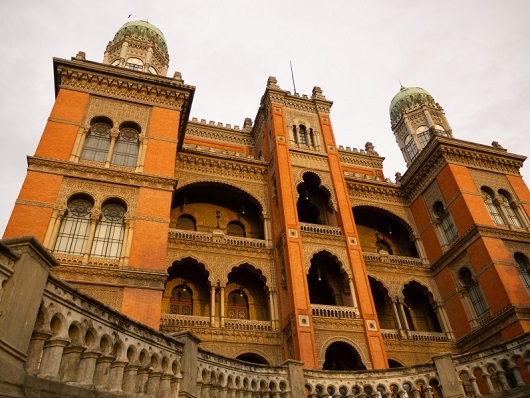Virtual tour of Mourisco Castle is launched
21/06/2019
Icict/Fiocruz
The Mourisco Pavilion, better known as “Fiocruz Castle", is a reference for whoever passes along Avenida Brasil, arriving or leaving the city of Rio de Janeiro, going to or returning from work. “A castle in the middle of the forest”, some say. “A childhood memory", others point out. An icon in the mind of Rio de Janeiro residents (known as Cariocas), the building is also a symbol of Brazilian science.

Not everyone knows however, that this castle contains many treasures. Mosaics inspired by Arabian carpets. Books, photos, documents and historical objects. Entomological collections exhibiting insects from various regions of Brazil. Architectural details that, in addition to being rare, witnessed the birth and development of Brazilian public health. Now, it is possible even for those who have never set foot in Rio de Janeiro to make a full visit to Mourisco Castle. All of this thanks to the 360o Tour, a virtual tour developed by the Institute of Communication and Information about Health (Icict/Fiocruz), in partnership with other areas of Fiocruz, such as the Presidency Office, the General Administrative Coordination Office (Cogead), Bio-Manguinhos and Casa de Oswaldo Cruz (COC). The launch of this virtual tour took place this Friday (5/31), during the celebrations of the 119-year history of Fiocruz.
A web product that can be accessed by computer, tablet and mobile phone, the virtual visit to the Mourisco Castle is full of surprises. As you progress through the stairways and corridors of the building, Internet users find icons that open windows with historical information, curiosities and the description of architectural details. In addition, they can access the exhibitions, in a similar way to what is already done in virtual museum environments around the world.
The technical leader for the creation of the 360o Tour is Leonardo Oliveira, systems analyst at the Icict/Fiocruz Center for Information Technology and Communication in Health (CTIC). A fan of technology, he says that he always walked through the Manguinhos campus imagining what it would be like to reproduce the surprises of this visit for the online public. “I wanted to do something like the virtual tours of museums such as the Louvre, in France, the Natural History museum, in the United States, the Oscar Niemeyer museum, in Curitiba, and the Casa de Portinari Museum, in São Paulo. The Mourisco Castle is already open to public visitation and is a part of the list of guided visits that Fiocruz offers to the population, free of charge. The virtual tour, however, takes to an even larger public the beauties and stories of the building. The tour is an invitation so that people from Brazil and even from abroad can come to know the history of Fiocruz better. It is also a way of drawing even closer to the population”, states the analyst.
Real construction
Besides the CTIC, other sectors of Icict/Fiocruz are included in the virtual tour project: the Manguinhos Library, the Section of Rare Works, and the Multimeios and VideoSaúde sections. From Casa de Oswaldo Cruz (COC), the Historical Heritage Department (DPH) and the Museum of Life participated. Leonardo highlights the involvement of so many teams as the asset of the project: “The involvement of so many different areas of Fiocruz was essential for the creation of the tour”.
Diversity and teamwork, after all, are key words in the history of the castle itself, the sketch for which was made by Oswaldo Cruz himself, but it was designed by the architect, Luiz Moraes Junior. Its construction began in 1905, and it was completed in 1918. The neo-Moorish inspiration came from the Alhambra Palace, in Granada (Spain), but its style is considered eclectic. Since 1981, the architectural features of the Mourisco Castle are listed by the National Institute of Historic and Artistic Heritage and, currently, it is a candidate for the World Heritage Program by Unesco.

To do justice to this icon, namely, the Fiocruz Castle, Leonardo reports that it involved not only a lot of work, but also a little help from meteorology. Using cutting edge equipment, the team had to take numerous photos not only of the castle, but also, of the campus. This would only have the desired effect if the natural lighting were the best possible. "There were several meetings to define the tour, the places where we would take the photos, the information filter, we had to get used to the 360-degree camera. We did a lot of light tests so that all the details were sufficiently clear. And we had to identify the best times of the day for registering everything. More than a thousand photos were taken", says the analyst. Some of these photographs became part of Fiocruz Imagens, a free database of visual records that is managed by Multimeios, also by Icict/Fiocruz. The recently launched Mourisco Castle Gallery displays more than 400 photos.
Combining pictures and information
The work of combining so much information was meticulous. The production of the Virtual 360-degree Tour of the Fiocruz Castle began in October 2018 and required many hours of tests so that the site could be viable and applicable. “The Virtual Tour (VT) in 360 degrees of the Fiocruz Castle will continue as part of the Fiocruz Portal”, explains Leonardo, adding that the virtual visit is also a way of preserving the history of the Castle.
Besides the analyst, journalist Daniele Souza, web designer Bruno Oliveira, and photographer, Rodrigo Méxas also worked directly on the project. The project also received the collaboration of web designer Paloma Lima, in Multimeios/Icict, Marcelo Garcia, coordinator of the Fiocruz Portal, and of web developer, Pedro Teixeira (CTIC/Icict). “We really enjoyed working on this project because we also ended up getting to know a little more about Fiocruz and the castle”, said Leonardo with enthusiasm.


